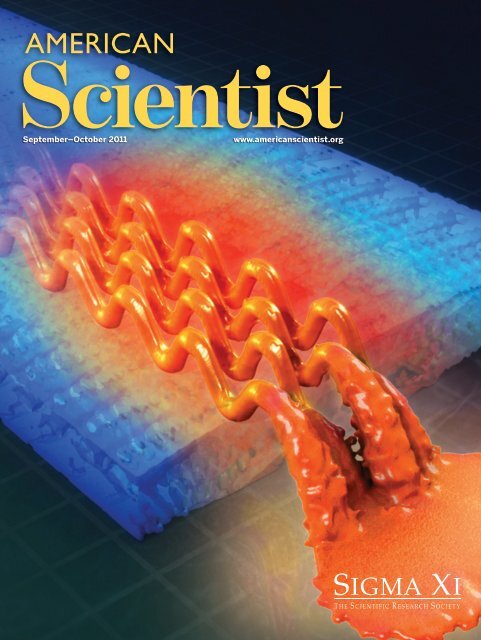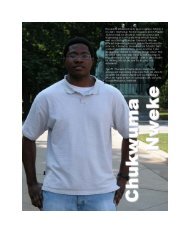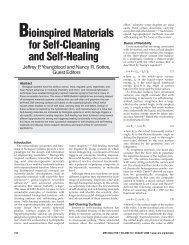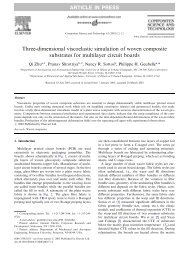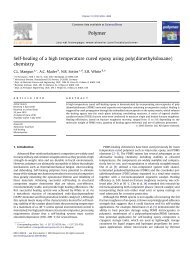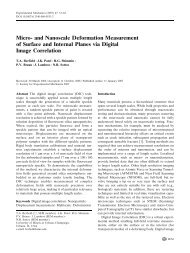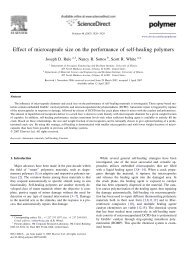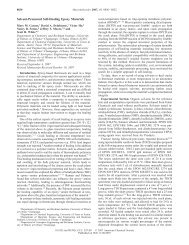Self-healing Polymers and Composites - Sottos Research Group
Self-healing Polymers and Composites - Sottos Research Group
Self-healing Polymers and Composites - Sottos Research Group
Create successful ePaper yourself
Turn your PDF publications into a flip-book with our unique Google optimized e-Paper software.
A reprint fromAmerican Scientistthe magazine of Sigma Xi, The Scientific <strong>Research</strong> SocietyThis reprint is provided for personal <strong>and</strong> noncommercial use. For any other use, please send a request to Permissions,American Scientist, P.O. Box 13975, <strong>Research</strong> Triangle Park, NC, 27709, U.S.A., or by electronic mail to perms@amsci.org.©Sigma Xi, The Scientific <strong>Research</strong> Society <strong>and</strong> other rightsholders
<strong>Self</strong>-<strong>healing</strong> <strong>Polymers</strong> <strong>and</strong> <strong>Composites</strong>Capsules, circulatory systems <strong>and</strong> chemistry allow materials to fix themselvesScott R. White, Benjamin J. Blaiszik, Sharlotte L. B. Kramer, Solar C. Olugebefola,Jeffrey S. Moore <strong>and</strong> Nancy R. <strong>Sottos</strong>Nothing lasts forever. Any humanmadematerial, used in anythingfrom toys to bridges, will eventuallyfail, if not maintained <strong>and</strong> repaired.Traditionally, this problem has been addressedthrough extensive inspection<strong>and</strong> expensive replacement of damagedparts. Biological systems, however, haveevolved to include alternative ways torepair internal <strong>and</strong> external damage via<strong>healing</strong> mechanisms. Materials researchersworldwide, including those in ourgroup, have been working on methods tomimic these <strong>healing</strong> abilities in polymers,composites <strong>and</strong> other synthetic materials.Such self-<strong>healing</strong> materials, when triggeredby a crack or tear, can repair themselves<strong>and</strong> recover their original functionalityusing only the materials that areinherently available to them. They offer anew means to achieve safer <strong>and</strong> longerlastingproducts <strong>and</strong> components, <strong>and</strong>signal a shift in the traditional paradigmsof material design <strong>and</strong> engineering.The guiding principles for syntheticself-<strong>healing</strong> are seen in biological systems.Damage that causes injury triggersthe first response, inflammation<strong>and</strong> blood clotting. This initiating stepis followed by cell proliferation at thesite of injury, which deposits a matrixfor the repair. The final stage of <strong>healing</strong>,matrix remodeling, is the regrowthof new tissue to fill in the wound. Thisprocess can take place over a longerScott R. White is a professor of aerospace engineeringat the University of Illinois. Benjamin J. Blaiszik is apostdoctoral fellow at the Center for Nanoscale Materialsat Argonne National Laboratory. Sharlotte L.B. Kramer <strong>and</strong> Solar C. Olugebefola are postdoctoralresearchers, Jeffrey S. Moore is a professor of chemistry<strong>and</strong> Nancy R. <strong>Sottos</strong> is a professor of materialsscience at the University of Illinois. This article wasadapted from Blaiszik, B. J., et al. 2010. <strong>Self</strong>-<strong>healing</strong><strong>Polymers</strong> <strong>and</strong> <strong>Composites</strong>. Annual Review ofMaterials <strong>Research</strong> 40:179–211. Address for White:Department of Aerospace Engineering, Universityof Illinois, Urbana-Champaign, Urbana, IL 61801.E-mail: swhite@illinois.eduperiod, months to possibly years, dependingon the severity of the injury.In synthetic systems, there is a similarcascade of events, but it is more simplistic<strong>and</strong> takes place at a faster rate. At first,damage actuates the start of the process,then new materials are transported tothe site rapidly, <strong>and</strong> <strong>healing</strong> occurs asthe material reacts to form an adhesivebond with the damaged area. Most oftenthe <strong>healing</strong> agent is made of two typesof liquid materials that solidify whenmixed. Finally comes a chemical repairprocess, analogous to matrix remodeling;its timescale varies depending onthe type of <strong>healing</strong> mechanism, but itoccurs in the range of hours to severaldays at most. The goal of self-<strong>healing</strong> isto match the rate of repair with that ofthe damage, thereby achieving a state ofstasis in the material. The rate of damageis largely controlled by external factors,such as the material’s strain rate, howfrequently it experiences loading <strong>and</strong> themagnitude of the loading. However, the<strong>healing</strong> rate can be adjusted by, for example,varying temperature or chemicalreactionrates through control of rawmaterialtypes <strong>and</strong> concentrations.<strong>Research</strong> on self-<strong>healing</strong> materials isrelatively new, with most of the progresscoming within the last decade. Althoughin theory any material can self-heal, theresults for polymers <strong>and</strong> fiber-reinforcedcomposites are relatively more maturein comparison with efforts in ceramics,metals <strong>and</strong> other materials. Whateverthe class of material, self-<strong>healing</strong> mechanismscan be broadly classified into threegroups: capsule-based, vascular <strong>and</strong> intrinsic.Each group differs by the methodused to sequester the material’s <strong>healing</strong>functionality until it is triggered by damage.The groups also vary by the differentamounts of damaged volume thatthey can heal, as well as the repeatabilityof <strong>healing</strong> in the same location <strong>and</strong> therate of <strong>healing</strong>. Thus each approach hasits own challenges <strong>and</strong> advantages.Capsule-based materials incorporatea <strong>healing</strong> agent that is held <strong>and</strong> protectedin discrete spherical shells, which areruptured by damage. The self-<strong>healing</strong>mechanism is activated by the release<strong>and</strong> reaction of the <strong>healing</strong> agent at thedamage site. However, after release,the <strong>healing</strong> agent is depleted, so it onlyworks for a single local <strong>healing</strong>.Vascular materials carry the <strong>healing</strong>agent in a network of capillariesor hollow channels, which may besingle tubes, discrete planes of interconnectedtubes, or three-dimensionalnetworks of channels. When damageruptures the vasculature <strong>and</strong> deliversthe <strong>healing</strong> agent, the network can berefilled (either from an external sourceor from undamaged, connected channels),so it can support multiple local<strong>healing</strong>events.Intrinsic materials instead have a latentself-<strong>healing</strong> ability, usually builtinto the chemical network of the polymermaterial, rather than a separate,sequestered <strong>healing</strong> agent. They rely onrepairs made through molecular-scalemechanisms, such as hydrogen bonding,ionic interactions or polymer-chainmobility <strong>and</strong> entanglement. Each ofthese mechanisms is reversible, makingmultiple <strong>healing</strong>s possible.Raw MaterialsFor capsule-based materials, there are anumber of techniques for creating polymershell walls that protect the reactivematerials inside them. The most commonmethods involve forming a shellat the interface of droplets in an oil-inwateremulsion. In this case, the resultingshell will be thin <strong>and</strong> brittle, likethat of an egg, <strong>and</strong> it will rupture whenforce is applied. Another procedure involvesemulsifying a melted polymerso that it forms droplets, which are thensolidified by a temperature change orby the removal of a solvent, creating athick protective sphere around the core.392 American Scientist, Volume 99 © 2011 Sigma Xi, The Scientific <strong>Research</strong> Society. Reproductionwith permission only. Contact perms@amsci.org.
15 micrometersFigure 1. Fibers destined to reinforce a composite material are coated with capsules that act as a repair system. The glass fibers, about 15 micrometerswide, are smaller than the diameter of a human hair, <strong>and</strong> the capsules are about 10 times smaller. The capsules are filled with a liquid <strong>healing</strong> agentthat spills out when a crack ruptures them. Such self-<strong>healing</strong> agents can also be delivered by networks of channels, or they can be built directly into thechemistry of the material. (Image reprinted from B. Blaiszik et al., Advanced Functional Materials 20:3547, with permission of John Wiley <strong>and</strong> Sons.)Once the <strong>healing</strong> agent is protected insidecapsules, the next step is to incorporatethem into a polymer. In practice,capsules have been shown to surviveshear forces, temperature changes <strong>and</strong>other processing conditions encounteredduring mixing with various matrices, orbody materials, at multiple scales. Afterthe capsules are integrated, the compositematerial can be characterized, as thecapsules can affect the mechanical propertiesof the material, such as its strength,fracture toughness <strong>and</strong> elasticity. Theeffectiveness of the triggering mechanism<strong>and</strong> <strong>healing</strong> performance can bevalidated after the fact using a numberof imaging methods, such as optical microscopy,infrared or x-ray spectroscopy,or scanning electron microscopy.Each <strong>healing</strong> event requires at leasttwo materials: the <strong>healing</strong> agent <strong>and</strong> apolymerizer, which makes it solidify. Withcapsules, several arrangements can beused to ensure that the materials don’tcome into contact until <strong>healing</strong> is needed.In all cases, the <strong>healing</strong> agent is placed incapsules, but there are different methodsfor incorporating the polymerizer. Forinstance, the catalyst simply can be distributedfreely through the bulk of themain material. Several types of materials,including epoxies <strong>and</strong> fiber-reinforcedcomposites, have been tried with this arrangement,<strong>and</strong> our group has foundthat the resulting materials have high<strong>healing</strong> efficiencies <strong>and</strong> have extendedlifespans when subjected to fatigue loading.A variation on this method is to enclosethe polymerizer in wax spheres thatprotect the relatively sensitive chemicalfrom the harsh matrix environment.Another approach is to sequesterboth the <strong>healing</strong> agent <strong>and</strong> the polymerizerin separate capsules. This methodproves particularly useful when thereare more than two materials required inorder to make a repair. The capsules forthe different substances don’t have to beof the same type, as some componentsmay react differently with the shell wall.Some of our work on this multicapsulemethod has been used for corrosion inhibition,where a separately encapsulatedresin <strong>healing</strong> agent <strong>and</strong> a tin-basedcatalyst were incorporated into an epoxycoating. The same approach has beenapplied in a self-sealing laminated composite.Other research groups have developedsimilar strategies with differentagents <strong>and</strong> polymerizers.It is also possible to incorporate thepolymerizer as a latent ability in thematrix itself, as either a residual part ofthe matrix polymerization reaction, orone that results from an environmentalstimulus. One example we have researchedis adding an excess of organiccompounds called amines to an epoxymatrix, which initiate polymerizationwhen the <strong>healing</strong> agent is delivered.Other research relies on environmentalstimuli to produce a reaction, suchas oxidation or evaporation. And finally,one of the agents may be phaseseparated,or dispersed as small, insolubledroplets within the bulk material,providing a latent reactivity for <strong>healing</strong>.More DimensionsEncapsulated <strong>healing</strong> agents have greatpotential but come with a significantlimitation: They are finite in volume<strong>and</strong> allow only one local <strong>healing</strong> event.This restriction has led researchers todevelop vascular self-<strong>healing</strong> materials,drawing inspiration from the robustdistributed vascular networksin biological systems. In the syntheticapproach, one network of capillariesor hollow channels holds the <strong>healing</strong>www.americanscientist.org© 2011 Sigma Xi, The Scientific <strong>Research</strong> Society. Reproductionwith permission only. Contact perms@amsci.org.2011 September–October 393
a capsule-basedb vascularcintrinsicFigure 2. <strong>Self</strong>-<strong>healing</strong> systems are divided into three major categories. Capsule-based systems (a) sequester <strong>healing</strong> agents (blue), <strong>and</strong> polymerizers(red), in shells throughout the material. Vascular systems (b) use a network of refillable channels to deliver both <strong>healing</strong> agent <strong>and</strong> polymerizer.Intrinsic systems (c) utilize the reversible nature of certain chemical bonds to incorporate <strong>healing</strong> abilities directly into the material.agent, while an interspersed but unconnectedsecond network holds thepolymerizer. The network’s size, itswall stiffness, its bonding with the matrix,its fraction of the material’s overallvolume, <strong>and</strong> the channel distribution<strong>and</strong> uniformity all affect the mechanicalproperties of the material. Many ofthe design challenges are the same asfor capsule systems—researchers mustwork out the effect on mechanical properties,efficiency of triggering, <strong>and</strong> qualityof <strong>healing</strong> performance. However,the challenges of fabrication <strong>and</strong> integrationwith the bulk matrix materialare where the two systems diverge.Unlike capsule-based systems, vascularnetworks receive the <strong>healing</strong>agent after the network is in place,usually by applying a vacuum. So thechoice of <strong>healing</strong> agents must accountfor properties such as surface wettability,viscosity <strong>and</strong> chemical reactivity. Ifan agent has a high viscosity or a lowability to wet (or adhere to) a surface,it may not be able to efficiently fill anetwork—<strong>and</strong> it might not be releasedor transported well to damage sites.Obviously, if it’s chemically incompatiblewith the vasculature, the long-termstability of the system is questionable.Perhaps the simplest technique toassemble a vascular network is to usehollow glass fibers as channels. The fibersare easily made with existing technology,they are compatible with manyst<strong>and</strong>ard polymer materials, <strong>and</strong> theglass does not react with many popularself-<strong>healing</strong> agents, such as two-parta capsule-catalyst 200 micrometersb multicapsule300 micrometers1212clatent functionality100 micrometers d phase separation50 micrometers1 212Figure 3. Capsule-based <strong>healing</strong> methods differ in the ways that they sequester the polymerizer (2) that reacts with the <strong>healing</strong> agent (1).Capsule-catalyst systems (a) incorporate the polymerizer directly into the material (yellow). Multicapsule systems (b) have separate capsuletypes for both polymerizer <strong>and</strong> <strong>healing</strong> agent. It is also possible to incorporate the polymerizer as a latent functionality in the matrix itself (c)to react with a released <strong>healing</strong> agent. Finally, the polymerizer can also be phase separated (d), dispersed as insoluble droplets within the material.(Image in a reprinted from E. N. Brown et al., Experimental Mechanics 42:372, with permission from Springer. Image in b reprinted fromM. W. Keller et al., Advanced Functional Materials 17:2399, in c from M. M. Caruso et al., Advanced Functional Materials 18: 1898, <strong>and</strong> in d fromS. H. Cho et al., Advanced Materials 21:645, all with permission from John Wiley <strong>and</strong> Sons.)394 American Scientist, Volume 99 © 2011 Sigma Xi, The Scientific <strong>Research</strong> Society. Reproductionwith permission only. Contact perms@amsci.org.
epoxy resins. Also, these hollow fiberscan be interwoven with the glass <strong>and</strong>carbon-fiber reinforcements used incomposites, as they are of similar size<strong>and</strong> shape. In the first experimentalsystems, channels were made of fibersa millimeter in diameter, but fibers 15micrometers in diameter are now available.However, one big drawback tousing hollow glass fibers is that they arerestricted to one-dimensional connections;they cannot be made into morecomplex vascular networks.Additional connectivity, in two- orthree-dimensional networks of channels,gives vascular systems numerousperformance advantages. Each pointin these networks has multiple connections,so the system has greater reliabilityin case of blockages, as wellas access to a larger reservoir of <strong>healing</strong>agents, which means it not onlycan fix larger areas of damage but alsocan more easily be refilled for repeateduse. Two-dimensional networksare particularly useful in compositematerials that are assembled essentiallyby stacking layers, because the2D network can be s<strong>and</strong>wiched in atthe interfaces between layers withoutsignificant impact on the mechanicalstrength of the final composite.In the technique most commonly usedfor building 2D <strong>and</strong> 3D connected networks,direct-ink writing, a scaffold is firstformed inside a mold, which is then filledwith a polymer precursor. After the polymersolidifies, the scaffold is chemicallydissolved, leaving behind a network ofhollow channels in the polymer. This approachoffers a great deal of control overthe shape of the network, but the choiceof matrix materials is limited to ones thatcan be formed around the scaffold.A recent advancement by our groupovercomes many of the limitations ofdirect-ink writing. Sacrificial fibers areinterwoven into a composite material,then evaporate at temperatures of 200to 240 degrees celsius. The fibers remainstructural up to 180 degrees so theycan be integrated with st<strong>and</strong>ard fibers.A 3D weaving process creates a wovenpreform, which is then infiltrated witha polymer matrix <strong>and</strong> heated to cure.Places where the sacrificial fibers crossin the weave create connections betweenchannels in the finished material. Unlikedirect-ink writing, which is difficult toscale up to commercial production, thesacrificial-fiber method uses conventionalmanufacturing techniques. We havecreated channels up to 1 meter long <strong>and</strong>with considerable vascular complexity.Various members of our researchgroup have had increasing success withthe development of multi-dimensionalnetworks. To underst<strong>and</strong> how to efficientlydesign 3D networks, we utilizeda modeling scheme based on genetic algorithmsto optimize properties such asreliability, network volume <strong>and</strong> channeldiameter. Other work used direct-inkwriting to mimic the structure <strong>and</strong> functionalityof epidermal tissue. In this case,a brittle epoxy coating containing a polymerizerwas deposited on a flexible epoxysubstrate with a 3D grid of channelsabout 200 micrometers in diameter. Surfacecracks in the coating released <strong>healing</strong>agent from the underlying vasculature.The network could be refilled <strong>and</strong> wefound that the samples could be healedup to seven times. To increase the numberof <strong>healing</strong> cycles, members of ourgroup next placed <strong>healing</strong> agents <strong>and</strong>polymerizers in two isolated networks,which extended the number of <strong>healing</strong>sto 16. By refining direct-ink writing methodsto create complex, isolated but interpenetratingnetworks, we have achievedmore than 30 repeated <strong>healing</strong> cycles ina coating. The most recent advances inmulti-dimensional vascular design alsoallow for repeatable <strong>healing</strong> of damage tothe bulk of the matrix material.a one-dimensional b two-dimensionalc three-dimensional100 micrometers5 millimeters 2 millimeters 5 millimetersFigure 4. Vascular self-<strong>healing</strong> networks keep <strong>healing</strong> agents (blue) <strong>and</strong> polymerizers (red) in separate channels. One-dimensional networks (a) canbe made from hollow glass fibers, an end view of which is shown in a scanning electron micrograph (a, bottom). Two-dimensional (b) <strong>and</strong> threedimensional(c) networks can be made by direct-ink writing a scaffold (b, bottom) or by interweaving sacrificial fibers with st<strong>and</strong>ard composite fibers(c, bottom). (Image in a is reprinted from G. Williams et al., <strong>Composites</strong> Part A 38:1525, with permission from Elsevier. Image in b is reprinted from C.J. Hansen et al., Advanced Materials 21:4143, <strong>and</strong> in c from Advanced Materials 23(32), both with permission from John Wiley <strong>and</strong> Sons.)www.americanscientist.org© 2011 Sigma Xi, The Scientific <strong>Research</strong> Society. Reproductionwith permission only. Contact perms@amsci.org.2011 September–October 395
abcreversible bondingchain reentanglementnoncovalent <strong>healing</strong>Figure 5. Intrinsic self-<strong>healing</strong> networks use three main schemes. Reversible bonding (a) takesadvantage of a polymer’s ability to revert back to its simpler components <strong>and</strong> then rebuildbonds. The mobility of materials at crack faces can be utilized to entangle polymer chainsthat span the damage (b). Noncovalent <strong>healing</strong> (c) relies on reversible hydrogen bonding orionic clustering, which manifests as reversible cross-links in polymers. Scanning electron micrographsof damage <strong>and</strong> <strong>healing</strong> by each method are shown at right. (Images in a are reprintedfrom E. B. Murphy et al., Macromolecules 41:5203, <strong>and</strong> in b from X. Luo et al., Applied Materials<strong>and</strong> Interfaces 1(3):612, both with permission of the American Chemical Society. Image in c reprintedfrom R. J. Varley et al., Acta Materialia 56:5737, with permission from Elsevier.)Built-in RepairOne of the major disadvantages of bothcapsule-based <strong>and</strong> vascular systems isthat they require that additional materials(<strong>and</strong> volume) be integrated into a material.A more elegant approach is to incorporate<strong>healing</strong> ability directly into thebasic nature of the material—an intrinsic<strong>healing</strong> system. Materials using such systemsachieve repair through the inherentreversibility of chemical bonds withinthe matrix polymer. Mechanisms includethermally reversible reactions, hydrogenbonding, coupling of ionomers, phase10 micrometers50 micrometers1 millimeter10 micrometers100 micrometerschange of dispersed, meltable thermoplastic,or molecular diffusion.Design of such materials can be lesscomplex than for capsule or vascularsystems, because <strong>healing</strong> agents don’thave to be sequestered or integrated,<strong>and</strong> there are no problems with compatibility.However, the main challengeassociated with intrinsic self-<strong>healing</strong>materials is that they need to have therequired mechanical, chemical <strong>and</strong> opticalbulk properties for the final product’sdesired use. In addition, intrinsicself-<strong>healing</strong> tends to work best whenthe damaged area is small, as rebondingrequires close proximity of thecracked surfaces, which limits repairin cases of extensive damage.A polymer material is made from thelinking of simpler components, calledmonomers. The material’s inherentability to reversibly transform frommonomers to cross-linked polymers,through the addition of external energy,is one way to effect intrinsic self<strong>healing</strong>.For instance, if a damaged areaof polymer is subjected to intense heator light, that may trigger an increase inthe mobility of material in the damageregion so that it can rebuild bonds <strong>and</strong>mend the polymer. A number of groupshave characterized polymers <strong>and</strong> compositesthat have achieved multiplethermal mending cycles.Another approach is to incorporate ameltable thermoplastic additive. Whenthis material liquefies, it disperses intocracks <strong>and</strong> mechanically interlocks withthe surrounding matrix material. Someadditives also exp<strong>and</strong> in volume whenthey are heated, filling in damage. Suchreactions can occur multiple times, <strong>and</strong>the materials have been shown to sustainloads in post-repair tests.In some cases, segments of the polymercan be made to have an electriccharge, <strong>and</strong> these pieces are called ionomers.Clusters of such ionic segmentscan act as reversible cross-links, interweavingacross a crack, when activatedby such external stimuli as heat or ultravioletradiation. Several groups havelooked at how such ionomeric materialsfared when punctured with projectiles,<strong>and</strong> have shown that the heat generatedby the projectile traveling throughthe material is sufficient to trigger self<strong>healing</strong>.The rate at which the hole issealed is virtually the same as that of theballistic damage (see Figure 8).<strong>Polymers</strong> can also be designed sothat they form strong associations at eitherend groups or side groups alongtheir long chains, via multiple reversiblehydrogen bonds. Such rubberymaterials have been shown to reformhydrogen bonds in areas of damagewhen the broken pieces are broughtback into close contact. Similarly, materialsmay achieve intrinsic self<strong>healing</strong>through enhanced moleculardiffusion, which promotes polymermovement <strong>and</strong> entanglement acrossa fracture. This method has also beenshown to inhibit corrosion of aluminum<strong>and</strong> zinc: The increased pH levels thataccompany cathodic corrosion induce396 American Scientist, Volume 99 © 2011 Sigma Xi, The Scientific <strong>Research</strong> Society. Reproductionwith permission only. Contact perms@amsci.org.
increased mobility of compounds in acoating, thus triggering self-<strong>healing</strong>.impact/indentationsurface crackingcreased to as much as a 80 percent whensamples were healed at an increasedtemperature of 80 degrees celsius. Fullrecovery of fracture toughness in suchmaterials seems to be limited in caseswhere few fibers bridge the damagedarea <strong>and</strong> where there is an uneven distributionof <strong>healing</strong> agents within the fractureplane. In a recent advancement, ourgroup has patterned capsule-based systemsdirectly onto the surface of the reinforcingglass fibers to specifically target<strong>and</strong> repair damage that affects the bondbetween the reinforcement <strong>and</strong> matrix.Initial testing has shown that as muchas 50 percent recovery of the interfacialbond between a glass fiber <strong>and</strong> epoxymatrix can be achieved. Our colleaguesat the University of California at LosAngeles tested carbon-fiber reinforcedcomposites containing an intrinsic selfdelaminationfiber rupture<strong>and</strong> pulloutfiberdebondingpuncturetransverse<strong>and</strong> shearcrackingdeep cutin coatingcorrosion inprotectedmetalcrazingablationscratchmicrocrackingopeningcrackFigure 6. Various forms of damage may require different systems, or even a combination ofsystems, to achieve optimal <strong>healing</strong>. Indentation, impact, exposure to corrosive environments,ballistic punctures, surface scratching <strong>and</strong> fatigue can lead to these various damage modes.When broken, the type of composite, the polymer matrix, <strong>and</strong> the rate <strong>and</strong> extent of loadingall influence the form <strong>and</strong> extent of damage that requires <strong>healing</strong>.Taking StockOptimally, a self-<strong>healing</strong> material willrecover at the same rate at which damageoccurs, maintaining material stasis.The vast majority of self-<strong>healing</strong> materialshave yet to reach this milestone (althougha few do accomplish it undersome circumstances). Healing efficiencycan be calculated as a ratio of the healedmaterial properties to the original materialproperties. The goal of any system is100 percent <strong>healing</strong> efficiency, <strong>and</strong> eachapproach to self-<strong>healing</strong> has at least onesuch successful example. Reported efficienciesfor various materials range from20 percent to more than 100 percent, incases where repaired areas were actuallytougher than the original material.The number of ways that a polymeror composite can be damaged is extensive.The list includes impact, fatigue,fracture, puncture <strong>and</strong> corrosion, <strong>and</strong>each of these types includes more specificmodes. For instance, impact caninduce surface cracking, subsurface delamination,polymer matrix cracking ortransverse ply cracking (in which newcracks develop to span between existingcracks). These damage modes affect notonly the material’s mechanical propertiesbut also its ability to act as a barrier.<strong>Research</strong>ers have studied not only therestoration of fracture properties but alsothe recovery of a material’s ability to preventthe leakage of a gas or liquid, or toprotect a substrate from corrosion.In order to test for recovery fromfractures under controlled conditions,samples of materials are subjected toall kinds of impacting, bending, pulling<strong>and</strong> tearing. In 2001 our group demonstratedthe first successful autonomicself-<strong>healing</strong> in an epoxy with a capsulebased<strong>healing</strong> system, which after <strong>healing</strong>recovered 75 percent of its originalmaterial properties. We also found thatmicrocapsules could increase the toughnessof undamaged epoxy, because thespheres absorb the energy of growingcracks, preventing their expansion.When we have tested fracture repairin fiber-reinforced composites, we havefound that incorporating microcapsulesthat are larger than the reinforcing fibersthickens the regions where layersare laminated together, which resultsin an initial decrease in fracture toughness.But after 48 hours of <strong>healing</strong> atroom temperature, previously fracturedsamples showed a <strong>healing</strong> efficiencyof about 40 percent, <strong>and</strong> this value in-top viewtenminutes3 millimeters3 millimetersside viewtenminutes5 millimeters 5 millimetersFigure 7. An intrinsic self-<strong>healing</strong> polymer is tested by cutting its surface <strong>and</strong> stretching it over a cylinder (left) in order to view the damage(middle) <strong>and</strong> <strong>healing</strong>. After 10 minutes, molecular diffusion <strong>and</strong> entanglement of dangling chains across the cut have healed the surface (right).(Images reprinted from M. Yamaguchi et al., Materials Letters 61:1396, with permission of Elsevier.)www.americanscientist.org© 2011 Sigma Xi, The Scientific <strong>Research</strong> Society. Reproductionwith permission only. Contact perms@amsci.org.2011 September–October 397
aballistic puncture ofionomeric polymer<strong>healing</strong> matrix capable of thermallyreversible reactions; they found thatthere was a 90 percent recovery for three<strong>healing</strong> cycles when microcracks theyinduced in the material were heated to150 degrees for one minute.Another test of self-<strong>healing</strong> fractures isto physically cut the surface of a polymersample <strong>and</strong> then optically evaluate boththe scratch damage <strong>and</strong> crack closure.In several studies, polymers with intrinsicself-<strong>healing</strong> systems were cut witha razor blade <strong>and</strong> healed by realigningthe pieces for 10 to 15 minutes at roomtemperature. The repaired samples werebent or deformed to check for reopeningccapsule-based anticorrosion1 220millimeters3 450micrometersdelamination <strong>and</strong> matrixcracking in glass FRCFigure 8. <strong>Self</strong>-<strong>healing</strong> materials are of particular interest for the recovery of barrier properties<strong>and</strong> enhanced corrosion resistance. When a projectile punctures a polymer that has an ionomericintrinsic self-<strong>healing</strong> system (a), the polymer, melted by the ballistic heat, elastically snaps backinto place; viscous flow <strong>and</strong> interdiffusion of the molten surfaces seal the remaining cracks. Aglass-fiber-reinforced composite (FRC) is damaged by indentation (b); cracks in cross section ofa control sample (top) are reduced via <strong>healing</strong> in a sample with a capsule-based system (bottom).Steel coated with an epoxy (c) is scratched <strong>and</strong> then examined both optically (top) <strong>and</strong> in scanningelectron micrographs (bottom), showing corrosion in a control sample (1 <strong>and</strong> 3) <strong>and</strong> improvedcorrosion resistance in a self-<strong>healing</strong> sample (2 <strong>and</strong> 4). (Images in b reprinted from J. L. Moll et al.,Journal of Composite Materials 44:2573, with permission of Sage Publications. Images in c reprintedfrom S. H. Cho et al., Advanced Materials 21:645, with permission from John Wiley <strong>and</strong> Sons.)b1 millimeter20millimeters50micrometersof the crack faces. Some samples wereweaker than their undamaged counterparts,but many showed no breaks in thehealed areas. Some of the same studiesexamined samples that were torn insteadof cut, with similar results.Fatigue is a common mode of failurein structural materials, <strong>and</strong> it presentsunique challenges when designingself-<strong>healing</strong> materials. The load a materialexperiences from fatigue dependson an array of variables, including thefrequency <strong>and</strong> amplitude of the appliedstress. To date, only a few studies of self<strong>healing</strong>systems have looked at fatiguedamage. Our group <strong>and</strong> others haveinvestigated the relationship betweenthe damage rate, the <strong>healing</strong> rate <strong>and</strong>material life extension in these systems.When the damage rate is faster than the<strong>healing</strong> rate, damage accumulates <strong>and</strong>the material eventually fails. To counteractthis result, faster chemistries or longerrest periods for the material may berequired. However, when the damagerate <strong>and</strong> <strong>healing</strong> rate are balanced, significantlife extension has been shown.Impacts can also produce massivedamage volume, <strong>and</strong> can take on variousmodes of failure, such as puncture,delamination or mixed-mode cracking.So far, the focus of testing has been onquantifying the restoration of compressionstrength after low-velocity impact.Our colleagues at the University of Bristolhave tested carbon-fiber reinforcedepoxy with a hollow-glass-fiber networksfilled with <strong>healing</strong> agent, whichwas subjected to a range of impact energiesup to 3 joules. They found that thehollow-fiber system absorbs significantenergy as it fractures on impact, increasingcompression strength by 13 percent.Elevated temperatures allowed significant<strong>healing</strong> of the damage, but thestudy also demonstrated the material’ssensitivity to the uniformity of the channelsdistributed within the laminate.Studies of impact damage on capsulebased<strong>healing</strong> have shown mixed results.Our colleagues at ZhongshanUniversity in China tested woven-glassfiber-reinforced composites containing<strong>healing</strong> capsules. At impact energiesranging from 1.5 to 3.5 joules, they foundclose to 100 percent <strong>healing</strong> efficienciesfor the 1.5-joule impacts, but only about20 percent efficiency for the 3.5-joule impacts.However, when our group testeda similar material at impact energies of13 to 45 joules, despite extensive crackingof the sample, <strong>healing</strong> efficiency wasfound to be nearly 100 percent for impactsup to 20 joules; this efficiency decreasedas the damage volume increasedat higher impact energies.Testing with a milder form of impact,indentation, can lead to more controlleddamage. The group at the University ofBristol has used this method extensivelyon epoxy composites with hollow glassfibers to assess the release <strong>and</strong> transportof <strong>healing</strong> agents, mechanical performance<strong>and</strong> environmental aging.Besides bulk samples, our group hasalso tested the self-<strong>healing</strong> ability ofpolymer samples, such as thin bladdersor composite s<strong>and</strong>wich panels, to act asbarriers to gas <strong>and</strong> fluid flow. For ex-398 American Scientist, Volume 99 © 2011 Sigma Xi, The Scientific <strong>Research</strong> Society. Reproductionwith permission only. Contact perms@amsci.org.
ample, we have looked at thin bladderswhere a microcapsule <strong>healing</strong> systemwas s<strong>and</strong>wiched between two epoxycoatednylon layers. The bladders werepunctured with hypodermic needles<strong>and</strong> then allowed to heal for 24 hours.The <strong>healing</strong> efficiency, measured by theeffectiveness of sealing the holes, rangedfrom 40 to 100 percent, depending onmicrocapsule size <strong>and</strong> concentration.Finally, there are corrosion-resistantcoatings, critical protection for metalparts that operate in wet or salty environments.Barrier coatings lose their protectiveabilities once they are scratchedor abraded, making them obvious targetsfor self-<strong>healing</strong> systems. Samplesare tested by scoring the coating <strong>and</strong>then subjecting the material to salt water<strong>and</strong>, sometimes, to ultraviolet light.Recovery is determined by either visiblecorrosion in the cut or by the electricalconductance of the surface; an intactcoating should have more impedancethan bared metal.Several groups have the tested corrosionresistance of capsule-based coatingsystems containing linseed oil, camphoroil <strong>and</strong> tung oil, among others.In our labs we have shown remarkableperformance for epoxy <strong>and</strong> vinyl-basedcoatings with capsule systems, uponexposure to salt water. Intrinsic <strong>healing</strong>systems are particularly well suited forbarrier protection, as they emphasizethe <strong>healing</strong> of small defects, <strong>and</strong> severalgroups have reported complete corrosionsuppression with such systems.Increasing LongevityThe nascent field of self-<strong>healing</strong> materialsresearch has made great strides overthe past decade, but many technical challengesstill exist. Continuing progress inthe field will lead to new <strong>healing</strong> chemistriesthat possess greater stability, faster<strong>healing</strong> rates <strong>and</strong> higher reactivity. Buthow such materials will perform whensubjected to long-term exposure in harshenvironments remains an open question.The ultimate usefulness of self-<strong>healing</strong>systems will be in combating fatigue <strong>and</strong>periodic damage events, but the vast majorityof research thus far has focused onperformance in response to static fractures,not on the dynamic aspects of self<strong>healing</strong>under fatigue conditions.It is likely that large-scale applicationswill not incorporate fully distributedself-<strong>healing</strong> systems, but rather willemploy targeted <strong>and</strong> locally patternedself-<strong>healing</strong> components, in order to optimizecost, efficiency <strong>and</strong> detrimentaleffects to the overall properties of thematerial. For the field to gain traction,it is critical to have a near-term successfulcommercial demonstration of self<strong>healing</strong>.Most likely, this milestone willhappen first for coatings, as they areprevalent across many industrial applications<strong>and</strong> they require only modestmechanical performance compared tostructural components.But there are other material propertiesbesides mechanical ones that maybe good targets for self-<strong>healing</strong>. Forinstance, restoring conductivity couldbe highly beneficial for applications inenergy storage <strong>and</strong> microelectronics.Damaged computer chips might be ableto repair themselves on site, instead ofrequiring replacement. Our group <strong>and</strong>others have synthesized organometallicpolymers with semiconductor-level conductivitythat can self-heal with appliedheat, <strong>and</strong> we have recently demonstratedautomatic restoration of conductivityvia the delivery of highly conductivematerials from microcapsules.Restoration of optical properties mayalso be a fruitful path for self-<strong>healing</strong>research. Cracks have a different refractiveindex from the rest of a material, sothey scatter light <strong>and</strong> disrupt transparency.The ability of a vascular or capsule-basedsystem to deliver an indexmatchedpolymer to a site of damagecould enable autonomous mitigation ofthis problematic effect.Wherever materials are used, thereis hope that self-<strong>healing</strong> may lead to increasedsafety <strong>and</strong> utility, <strong>and</strong> decreasedcost over the lifetime of the material.Safer self-<strong>healing</strong> batteries, self-repairingautomobile coatings, resealing tires,fade-resistant fabrics <strong>and</strong> antitamperelectronics are all potential applications.But could the possibilities extendbeyond <strong>healing</strong>? Looking again to biologicalsystems for a road map, materialssuch as bone regenerate <strong>and</strong> remodel inresponse to stress <strong>and</strong> other stimuli. Itis possible that in the future, syntheticmaterials that currently can heal themselvesin response to damage may alsobe able to respond in a more complexfashion, regenerating <strong>and</strong> remodelingthemselves over their lifetimes.BibliographyBond, I. P., R. S. Trask <strong>and</strong> H. R. Williams.2008. <strong>Self</strong>-<strong>healing</strong> fiber-reinforced polymercomposites. MRS Bulletin 33(8):770–74.Bergman, S. D., <strong>and</strong> F. Wudl. 2008. Mendablepolymers. Journal of Materials Chemistry18(1):41–62.Blaiszik, B. J., M. Baginska, S. R. White <strong>and</strong>N. R. <strong>Sottos</strong>. 2010. Autonomic recovery offiber/matrix interfacial bond strength in amodel composite. Advanced Functional Materials20(20):3547–3554.Chen, X. X., et al. 2002. A thermally remendablecross-linked polymeric material. Science295(5560):1698–702.Cordier, P., F. Tournilhac, C. Soulie-Ziakovic<strong>and</strong> L. Leibler. 2008. <strong>Self</strong>-<strong>healing</strong> <strong>and</strong> thermoreversiblerubber from supramolecularassembly. Nature 451(7181):977–80.Hansen, C. J., et al. 2009. <strong>Self</strong>-<strong>healing</strong> materialswith interpenetrating microvascular networks.Advanced Materials 21(41):4143–47.Jones, A. S., et al. 2007. Life extension of self<strong>healing</strong>polymers with rapidly growingfatigue cracks. Journal of the Royal SocietyInterface 4(13):395–403.Kalista, S. J., T. C. Ward <strong>and</strong> Z. Oyetunji. 2007.<strong>Self</strong>-<strong>healing</strong> of poly(ethylene-comethacrylicacid) copolymers following projectile puncture.Mechanics of Advanced Material <strong>and</strong>Structures 14(5):391–97.Kessler, M.R., N. R. <strong>Sottos</strong> <strong>and</strong> S. R. White.2003. <strong>Self</strong>-<strong>healing</strong> structural composite materials.<strong>Composites</strong> Part A: Applied Science <strong>and</strong>Manufacturing 34(8):743–53.Patel, A. J., N. R. <strong>Sottos</strong>, E. D. Wetzel <strong>and</strong> S.R. White. 2010. Autonomic <strong>healing</strong> of lowvelocityimpact damage in fiber-reinforcedcomposites. <strong>Composites</strong> Part A: Applied Science<strong>and</strong> Manufacturing 41(3):360–68.Sauvant-Moynot, V., S. Gonzalez <strong>and</strong> J. Kittel.2008. <strong>Self</strong>-<strong>healing</strong> coatings: An alternativeroute for anticorrosion protection. Progressin Organic Coatings 63(3):307–15.Toohey, K. S., et al. 2007. <strong>Self</strong>-<strong>healing</strong> materialswith microvascular networks. Nature Materials6(8):581–85.Trask, R. S., H. R. Williams <strong>and</strong> I. P. Bond.2007. <strong>Self</strong>-<strong>healing</strong> polymer composites:Mimicking nature to enhance performance.Bioinspiration & Biomimetics 2(1):1–9.van der Zwaag, S. 2007. <strong>Self</strong> Healing Materials:An Alternative Approach to 20 Centuries ofMaterials Science. Dordrecht: Springer-Verlag.White, S. R., M. M. Caruso <strong>and</strong> J. S. Moore.2008. Autonomic <strong>healing</strong> of polymers. MRSBulletin 33(8):766–69.White, S. R., et al. 2001. Autonomic <strong>healing</strong> ofpolymer composites. Nature 409(6822):794–97.Williams, K. A., D. R. Dreyer <strong>and</strong> C. W. Bielawski.2008. The underlying chemistry of self-<strong>healing</strong>materials. MRS Bulletin 33(8):759–65.Wool, R. P. 2008. <strong>Self</strong>-<strong>healing</strong> materials: A review.Soft Matter 4(3):400–18.Youngblood, J. P., N. R. <strong>Sottos</strong> <strong>and</strong> C. Extr<strong>and</strong>.2008. Bioinspired materials for self-cleaning<strong>and</strong> self-<strong>healing</strong>. MRS Bulletin 33(8):732–41.Yuan, Y. C., et al. 2008. <strong>Self</strong>-<strong>healing</strong> polymericmaterials using epoxy/mercaptan as thehealant. Macromolecules 41(14):5197–202.For relevant Web links, consult thisissue of American Scientist Online:http://www.americanscientist.org/issues/id.92/past.aspxwww.americanscientist.org© 2011 Sigma Xi, The Scientific <strong>Research</strong> Society. Reproductionwith permission only. Contact perms@amsci.org.2011 September–October 399


